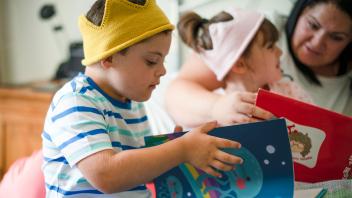Many classics of children’s literature involve animals that behave like people. I’ve certainly likened several two-legged people I know to Eeyore. I often think like the Cat in the Hat on a dull, rainy day, looking for good, clean, indoor mischief. And in my house, Farmer Duck became a metaphor for unappreciated hard work. A recent article reports that a Canadian psychologist suggests that books with anthropomorphized animals may be deleterious to children’s development; that reading more factual books about animals leads to a better knowledge of animals. (The abstract of the study is also available.) I say that is pure and simple poppycock. I’m a major fan of nonfiction in its myriad forms — narrative nonfiction, informational picture books, concept books etc. — but let’s get real. What captures readers of any age in books of fact? Sometimes it’s a simple love of factoids; but I know lots of people (and I include myself) like the stories found in nonfiction. However, children are not reading about Max and Ruby to find out about the lives of rabbits any more than Pooh is read to learn about bear habitats (stuffed or not). Parents who read these books to their children are sharing an experience, imparting perhaps the most important information of all: simply that books and stories are enjoyable; that feelings and emotions have been felt by others; and maybe, just maybe, young readers will develop a sense that they’re not alone and perhaps learn to laugh at their own foibles as they read about others. Equally important, children are exercising their imaginations — and just like other skills, imagination needs to be used or it will be lost. Winnie the Pooh, Mr. Toad, Max and Ruby and other animals are stand-ins for children. And it doesn’t matter if their hair is straight or curly, if there skin is white or brown or mottled. Children see themselves in them. Period. Children — like adults — need a balance of all types of books. The world is altogether too real for too many children as it is. Books with anthropomorphized animals (like books of fact) can be good or dreadful. But let’s not limit choices and increase the notion that one particular type of book for young children is better at creating tomorrow’s geniuses.
About the Author
Reading Rockets’ children’s literature expert, Maria Salvadore, brings you into her world as she explores the best ways to use kids’ books both inside — and outside — of the classroom.

